People
‘History Doesn’t Move in a Straight Line’: Photographer An-My Lê on How Pictures Can Help Us Keep Up With a Rapidly Changing World
The photographer's first career survey is on view now at the Carnegie Museum of Art.
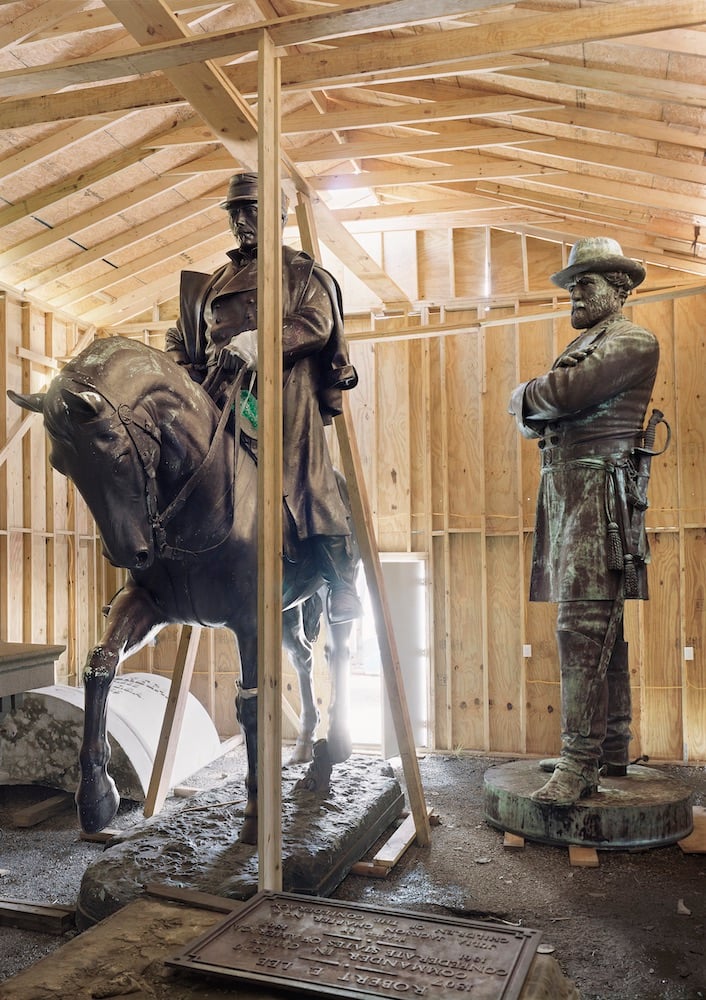
The photographer's first career survey is on view now at the Carnegie Museum of Art.

Taylor Dafoe

Though the earliest photographs from An-My Lê’s ongoing body of work “Silent General” were taken in 2016 and ‘17, they’re hard to distinguish from the images filling TV screens and Twitter feeds today: packed protests, fallen monuments, anti-Trump graffiti.
“It’s eerie to see how some of the issues that unfolded when I started ‘Silent General’ are now back at the forefront in an even more urgent way,” the Vietnam-born, New York-based photographer tells Artnet News. “History doesn’t move through time in a straight line.”
When we first met over video chat a couple weeks ago, the plan was to discuss Lê’s first career survey, “On Contested Terrain,” which is at the Carnegie Museum of Art in Pittsburgh (but is currently closed). But as the conversation spilled over into emails about Lê’s efforts to document the ongoing protests, it was “Silent General,” her latest project, named after a Walt Whitman phrase, that emerged as the focus.
One of the MacArthur “genius” grant-winning artist’s first pictures in the series depicts two confederate statues inside a quiet, ad-hoc shed in New Orleans. Rather than training her lens on the monuments’ removal, she focuses instead on their afterlife out of public view, the part no one looks at, or even thinks to.
This is signature Lê. Whether she’s photographing naval officers atop globe-spanning vessels, Vietnam War re-enactors in the American south, or Marines prepping for the Iraq War in the barren California desert, she zooms out to show the complex contexts of conflict. And she does so without judgement or admonition.
“Her nuanced and subtle photographs provide visual and emotional space for viewers, and pose important and timely questions,” says Dan Leers, curator of photography at the Carnegie Museum of Art, who organized Lê’s show there. “Is it our nature to be in conflict? How does the landscape record collective trauma? And what is the status of photographic truth in an age of alternative facts?”
“Lê’s absorbing images withhold easy answers,” he adds, “but we do find some possible paths forward.”
The title “Silent General” is taken from Walt Whitman’s book Specimen Days and Collect and is a reference to his description of Ulysses S. Grant. Your series, like Whitman’s book, is divided into “fragments.” Where did you come across that text, and what about its structure attracted you?
I’m not sure how I found it, but during trips made to photograph the confederate monuments I was always asking myself the question: What I am doing here? Especially when working alongside journalists. I am always interested in artists who work with topical, political issues and am curious about the ones whose approach provides a distinct perspective. I think of Errol Morris using reenactments in his documentaries. So, Whitman is an obvious choice because of the subject of the Civil War, the monuments, the democratic experience, and so on. It’s because Whitman, who was a newspaper man, transcends the journalistic and chronicling impulses in the work. Specimen Days was written late in his life and the section on the Civil War was based on his notes and sketches—it’s a kind of report of his experiences during the Civil War. But, in fact, they are reminiscences that are carefully crafted as part of a larger autobiographical tour de force. Throughout the work, he weaves his own experiences alongside major events to give his life relevance within the sweep of history and the establishment of democracy. As artists, I think we all want to be relevant.
Specimen Days is written in prose and it’s very specific and descriptive, but it’s also very lyrical and poetic. As a photographer I am always thinking about how to transform the barrage of searing descriptions my camera will record of the world into a final object that is more elusive and, hopefully, lyrical. I was inspired by the way Specimen Days is comprised of a series “essays,” which Whitman calls fragments. If you look at the different fragments, they seem disjointed at times—he can go from something very personal to something much less personal. He spoke about his stroke and his connection to the landscape in both an intimate way and a political one too. His meditations on the connections between geography, geology, and human history all made sense to me. I saw the fragments in the way one puts words together to form sentences.
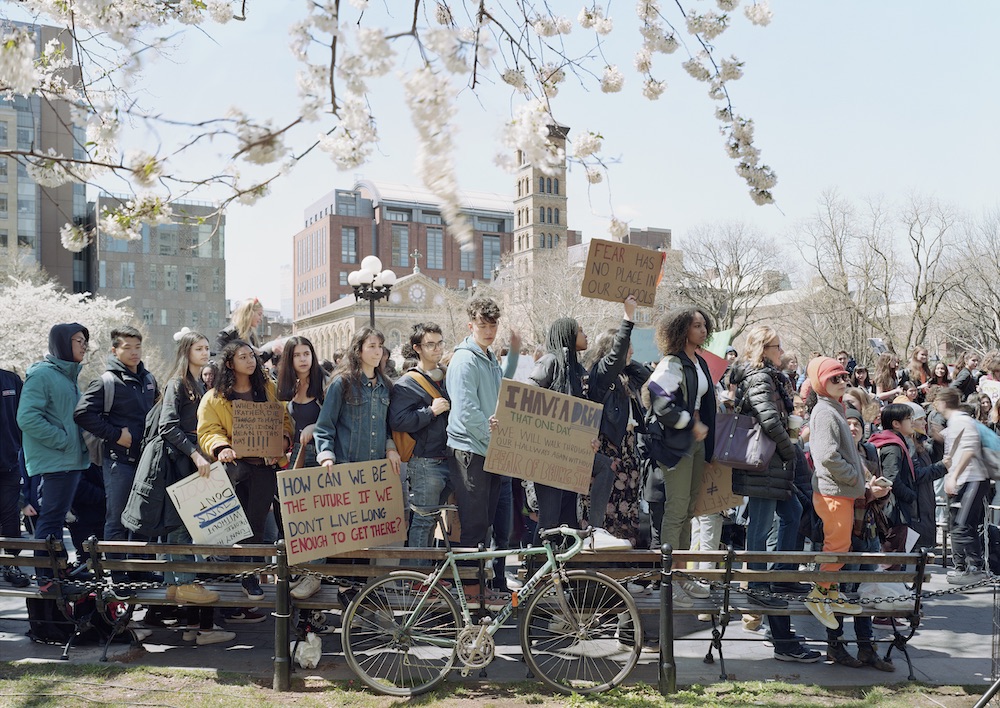
An-My Lê, Fragment VII: High School Students Protesting Gun Violence, Washington Square Park, New York (2018). Courtesy of the artist and Marian Goodman Gallery. ©2020 An-My Lê.
That phrase, “Silent General,” is pregnant with potential meanings. Does it represent anything in particular to you?
I love the fact that Grant was an average man; you would not think of him as someone who would distinguish himself. I have always been interested in the idea of a somewhat average guy who surpasses expectations and goes on to really make a difference.
Those two words really leapt off the page when I first came across them. Together, the idea of silence and, not the ranking commander, but the notion of generalization, resonated with the deeper themes I’ve been interested in. There is a juggling act between the two ideas that can be edifying. Photography is a kind of silence that is not silent. While the medium is all about depicting specificities, these depictions can convey trite generalizations which are not necessarily better than silence. In a way, the title encapsulates the struggle in the fight against generalization and simplification. I feel a great kinship for Specimen Days and for the work of any artist who is interested in approaching a political moment in ways that exemplify not just a subjectivity but also a crystalizing specificity that I believe is very different from rhetoric or propaganda.
In the past, you’ve said that you’re drawn to “worlds that are complete, inclusive, and integral while not necessarily without conflicts.” As a result, your bodies of work have felt contained, in a sense. Perhaps because of the nature of the project, “Silent General” feels wider in scope, even a little more abstract. At what stage are you in with this series? Is there an end in sight?
Trying to figure out when a project is finished is a big deal. At a certain point things become repetitive. I never thought of this before. Previous projects maybe had a second-person point of view. “Silent General,” like Whitman in Specimen Days, is more about my struggles as an author in the contemporary world. The work is not about me but it is about allowing my feelings, curiosities, and failures to be more present.
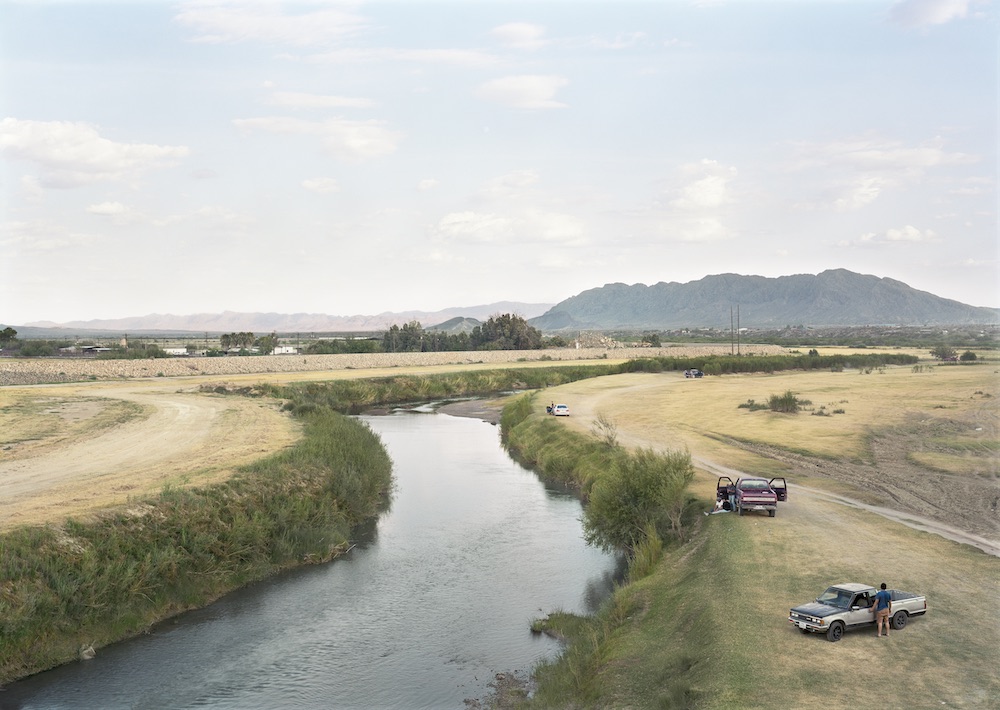
An-My Lê, Fragment VIII: Cars along the Rio Grande at the US-Mexico Border, Ojinaga, Mexico (2019). Courtesy of the artist and Marian Goodman Gallery. ©2020 An-My Lê.
I appreciate the fact that the subject was clearly defined in the past. [My series] “Small Wars” was about the Vietnam war re-enactors; “29 Palms” was confined to the Marine corps training base in California; “Events Ashore” was spread out over the world, but it was all about the US Navy. I knew where my work laid. What I have now takes place wholly in the US, but it is undefined, more organic, and, you are right, abstract. For me, it’s new and challenging and feels appropriate.
I didn’t quite appreciate the nature of this new work until about a year or a year and a half into it, when I realized that it was really an American road trip. I felt that I needed to do it, and I felt ready for it. I certainly don’t think I could have done it previous to the other projects. Since then, much of the work has been done in response to the anxiety and helplessness that I feel. So, I think as long as there’s a need to answer, to respond, I will continue.
You said you didn’t feel ready for an American road trip series until now. Other than the larger political climate, what, for you, has changed?
I certainly don’t sit down and decide that I need to do this or that because I feel that the voice of a woman, mother, or immigrant needs to be heard. Sometimes one’s own story becomes a catalyst for the work. The idea of the road trip came from my education as an artist and from a more self-conscious look back at the questions that came to me as a grad student. I was encouraged to look at my identity back then.
I don’t believe the road trip describes a method of making art. Within photography, the term road trip came to stand like a literary mode. It is a shorthand for a literary, flowing project that is not pre-conceived. It means going out to see the world. It involves crossing borders, moving between conservative and outsider spheres. It’s about others but also about being another. Most importantly for me this is an opportunity to engage with a fully present, participating landscape, a landscape that transcends the social, political, cultural moment.
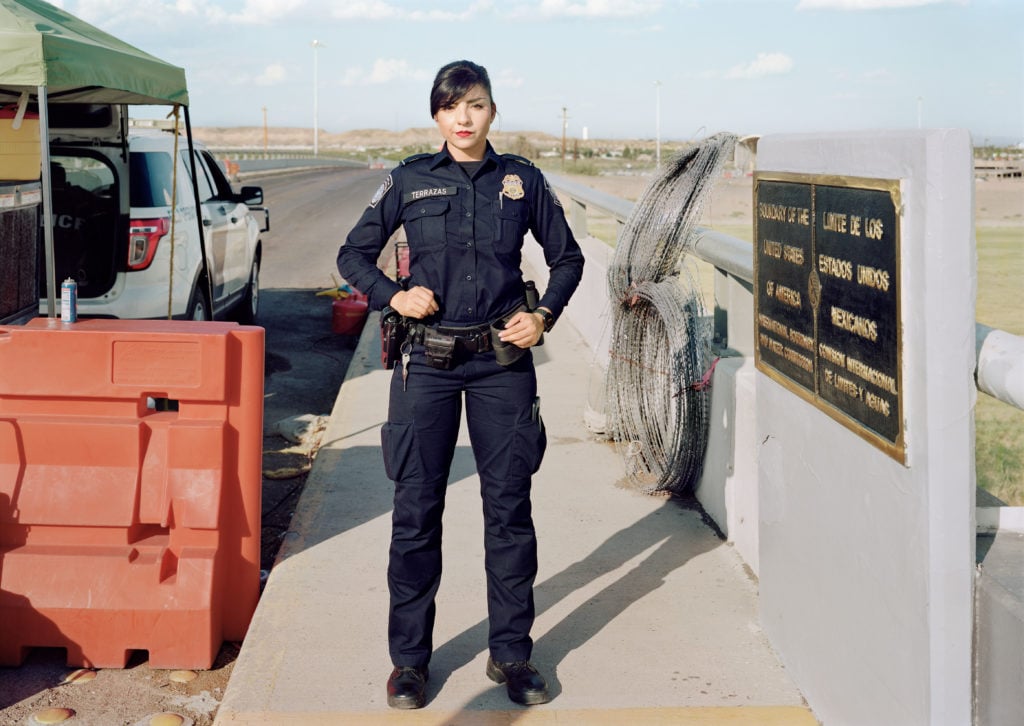
An-My Lê, Fragment VIII: US Customs and Border Protection Officer, Presidio-Ojinaga International
Bridge, Presidio, Texas (2019). Courtesy of the artist and Marian Goodman Gallery. ©2020 An-My Lê.
You’ve described yourself as a landscape photographer first and foremost and said that, despite all the political and cultural change you’ve witnessed throughout your life—both in Vietnam and America—the landscape has remained the one constant. Today, we don’t think of the landscape as a “constant”; it’s fraught with the possibility of change, depletion, destruction. How has your relationship to the landscape changed throughout your career?
My return to Vietnam in the mid-1990s was an extraordinary experience. There were some landscapes that I knew, but not many. When I was growing up, it was difficult to leave the safety of the city to go out and explore the land because of the fighting. And I certainly didn’t know the northern landscapes because the country was already separated when I was born. And yet, despite years of warfare, somehow there was a kind of familiarity that I was able to connect to when I returned and experienced the northern landscapes for the first time. There is a sense of the layering of history in the landscape, visible or not, that is ever-present. I do believe that landscape, in all its manifestations, is ever-powerful. It transcends politics and will prevail.
In my work, I am constantly casting and recasting the landscape. It is a force of nature: mercurial, volatile; it is my muse. The landscape can deliver cliché after cliché, but it always surprises me. If it does not represent a threat, then it’s about scale, like David and Goliath. I’ve always been fascinated in the relationship of one smaller thing to something larger. I’m also interested in labor and the way labor or any kind of human intervention marks up the landscape.
Whitman’s text is not very political, despite the backdrop of the war—he doesn’t “take a side,” so to speak. Similarly, the “Silent General” pictures—like most of your photos—don’t take a side. Why is that lack of judgement or moral bias important to you?
Well, I wouldn’t say that it’s completely lacking in bias. I’m photographing laborers and border guards after all. But I hate being told what to think and how to feel. My approach is also a reaction to the rhetoric—the slogan-filled and simplified language and approach to social and economic issues during the presidential debates in 2015 and ’16.
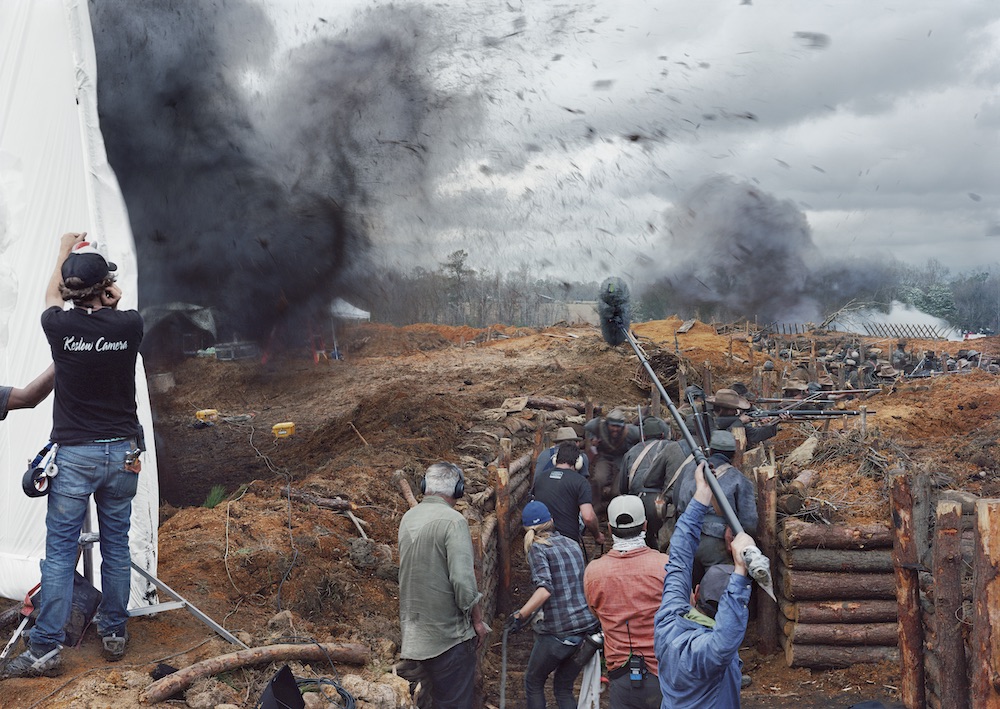
An-My Lê, Fragment I: Film Set (Free State of Jones), Battle of Corinth, Bush, Louisiana (2015). Courtesy of the artist and Marian Goodman Gallery. ©2020 An-My Lê.
I think some of the pictures are hopeful. If you look at them, it’s not about position taking. This is something I’ve learned before, from traveling and from being with the military. It’s very humbling to meet people who have completely different perspectives than you. Traveling for “Events Ashore” was a particularly rousing experience. What does it mean to not be able to find a job and having to join the military? What does it mean to give up your rights to make decisions because you will follow whatever the command decides or whatever American foreign policy dictates? What does it mean, as a woman, to be on a ship and try to perform a job in what was, until recently, a male dominated world and retain your identity as a woman while showing competency and professionalism? That experience made me realize that the world is far more nuanced and subtle than we often make it seem to be.
Many of the issues that inspired “Silent General”—the removal of monuments, the racial divide in America, and so on—are again playing out on the national stage. Indeed, the earliest pictures in the series look eerily similar to what’s in the news right now. What does that say to you?
When I started showing the early iterations of “Silent General” a couple years ago, I spoke about how I felt that war had come to the home front. That was my impetus for taking this road trip through America. Little did I know what would hit us this year. War and chaos really have come to our doorstep. It’s eerie to see how some of the issues that unfolded when I started “Silent General” are now back at the forefront in an even more urgent way. History doesn’t move through time in a straight line.